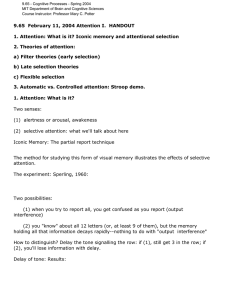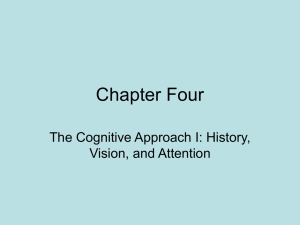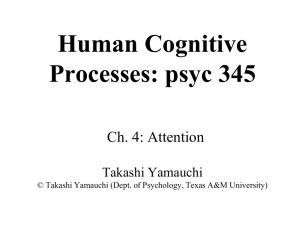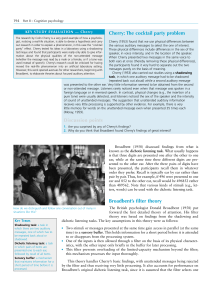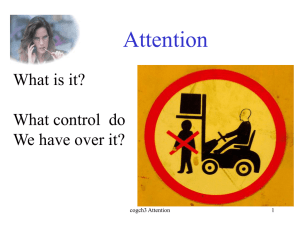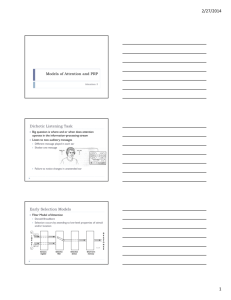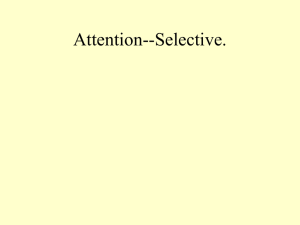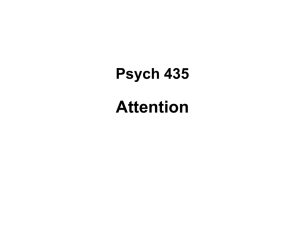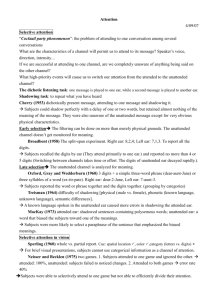attention!
advertisement
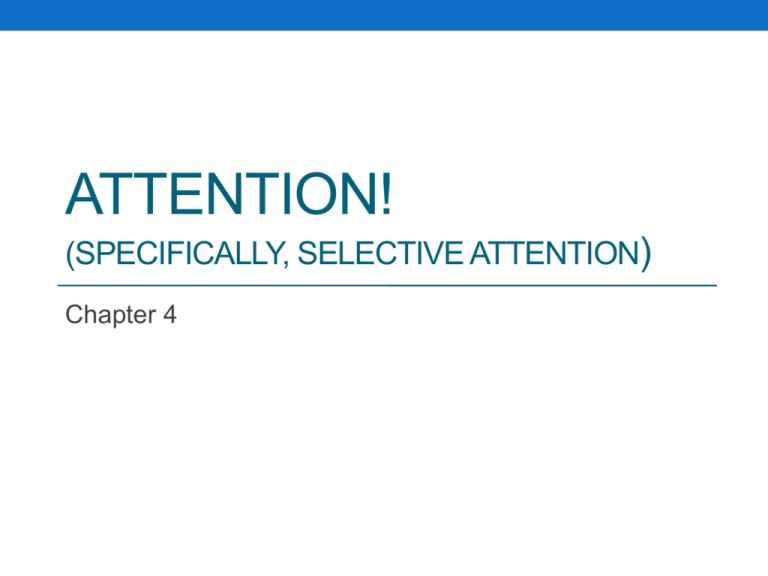
ATTENTION! (SPECIFICALLY, SELECTIVE ATTENTION) Chapter 4 Quiz • What is dichotic listening procedure? What is the shadowing procedure? • What is the cocktail party effect and what does it tell us about attention? Controlled attention • Deliberate, voluntary allocation of attention • Selective attention: attend to one source, ignore other sources • Attention metaphor: filter • Selective attention methods • Real world examples Selective attention: Visual tasks • Visual search • Conjunctive task (search for combo of 2 features) • Stroop task • Dual-component stimuli (color and word) • Instruction: say color of ink • Simon effect • See CogLab demo if interested! • Flanker compatibility task • Attend to center of display, ignore sides (“flankers”) • Instruction: say if target is present or not Flanker compatibility task • Compatible flankers: • Target and distractors lead to same response • Incompatible flankers: • Target and distractors lead to opposite responses • Neutral flankers: • Distractor is not connected to a response so only target provides response info • Lavie (2005) • IV: load (low-load vs high-load ease of finding target) • Result: distractor has more effect in low load condition than high • Conclusion: Ability to ignore task irrelevant info depends on cognitive resources available and power of stimuli to capture attention Selective attention: Auditory tasks • Dichotic listening • 2 auditory messages: 1 in each ear • Task: to attend to 1 ear • Shadowing task • Dichotic listening • Task: repeat content of 1 ear Early selection findings • Cherry (1953) dichotic listening findings • Don’t notice language or content of 2nd message • Do notice gender of 2nd message • Broadbent (1958) • “Split scan” method: Hear digits simultaneously in right/left ear • Recall items in any order or in pairs • Results: Report any order • Recall digits from one ear then other – 65% accurate • Results: Report in pairs • Forced to switch – 20% accurate Broadbent’s Filter Model of Attention • Bottleneck model: restricts info available • Filter selects info based on physical characteristics • Early selection theory Evidence against Broadbent’s model Moray (1959) • Method: • Shadow 1 ear • Name said in unattended message • Results/Conclusion: • 1/3 hear name = “Cocktail party effect” • Name not filtered so analysis of unattended message goes beyond physical characteristics Gray & Wedderburn (1960) • Method: • Shadow ear: “dear 7 Jane”; unattended ear: “9 Aunt 6” • Results: • Ss report hearing in shadowed ear “dear Aunt Jane” Treisman (1960) • Treisman (1960) results: • Attention can switch with message meaning • Unattended message “reduced” Treisman’s attenuation theory • 2-stage process: • Attenuator: Analyzes physical characteristics, language, and meaning • Analyze as much as needed to separate the messages • Leaky filter model • Dictionary unit: Decide if a word reaches threshold • e.g. listeners name as low threshold • Early selection theory (b/c filter early in processing) Norman’s Pertinence Model • Selection based on • Sensory information • Pertinence • Highest combination gets attention • Continuous process • Late selection theory MacKay (1973) • Method • Ambiguous sentence in attended ear • “They were throwing rocks at the bank.” • Bias word in unattended ear • Which test sentence closest in meaning • Result • Bias word influences sentence meaning • Conclusion • Unconscious processing of meaning of unattended information • Support for late selection Early vs. Late selection • How much is processed before selected? • Where does selective attention operate? • Early: filter at physical (sensory) analysis (fig a) • Late: filter at/after semantic analysis (fig b) Johnston and Heinz (1978) • Attention is flexible. • Selective attention can operate in multiple modes (early, middle, late). • But, later selection uses more of our limited attentional capacity • Trade-off: • Stage of processing VS. capacity • Time and accuracy • Experiment method: • Dual-task: shadow 1+ messages plus light detection • Messages differ physically or in meaning, or both Johnston and Heinz (1978)
